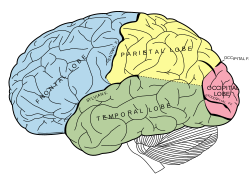Intraparietal sulcus
| Intraparietal sulcus | |
|---|---|
 Lateral surface of left cerebral hemisphere, viewed from the side. (Intraparietal sulcus visible at upper right, running horizontally.) | |
 Principal fissures and lobes of the cerebrum viewed laterally. (Fissures not labeled, but parietal lobe is colored yellow.) | |
| Details | |
| Part of | Parietal lobe |
| Identifiers | |
| Latin | sulcus intraparietalis |
| Acronym(s) | IPS |
| NeuroNames | 97 |
| NeuroLex ID | birnlex_4031 |
| TA98 | A14.1.09.127 |
| TA2 | 5475 |
| FMA | 83772 |
| Anatomical terms of neuroanatomy | |
The intraparietal sulcus (IPS) is located on the lateral surface of the parietal lobe, and consists of an oblique and a horizontal portion. The IPS contains a series of functionally distinct subregions that have been intensively investigated using both single cell neurophysiology in primates[1][2] and human functional neuroimaging.[3] Its principal functions are related to perceptual-motor coordination (for directing eye movements and reaching) and visual attention.
The IPS is also thought to play a role in other functions, including processing symbolic numerical information,[4] visuospatial working memory [5] and interpreting the intent of others.[6]
The IPS role in numerical cognition
Behavioral studies suggest that the IPS is associated with impairments of basic numerical magnitude processing and that there is a pattern of structural and functional alternations in the IPS and in the PFC in dyscalculia.[7] Children with developmental dyscalculia were found to have less gray matter in the left IPS.[8]
Other roles of the IPS
Five regions of the intraparietal sulcus (IPS): anterior, lateral, ventral, caudal, and medial
- LIP & VIP: involved in visual attention and saccadic eye movements
- VIP & MIP: visual control of reaching and pointing
- AIP: visual control of grasping and manipulating hand movements
- CIP: perception of depth from stereopsis
All of these areas have projections to the frontal lobe for executive control.
Activity in the intraparietal sulcus has also been associated with the learning of sequences of finger movements. (http://jn.physiology.org/content/88/4/2035.full)
Additional images
-
Lateral surface of left cerebral hemisphere, viewed from above.
References
- ^ Colby C.E., Goldberg M.E. (1999). "Space and attention in parietal cortex". Annual Review of Neuroscience. 22: 319–349. doi:10.1146/annurev.neuro.22.1.319. PMID 10202542.
- ^ Andersen R.A. (1989). "Visual and eye movement functions of the posterior parietal cortex". Annual Review of Neuroscience. 12: 377–403. doi:10.1146/annurev.ne.12.030189.002113. PMID 2648954.
- ^ Culham, J.C.; Nancy G. Kanwisher (2001). "Neuroimaging of cognitive functions in human parietal cortex". Current Opinion in Neurobiology. 11 (2): 157–163. doi:10.1016/S0959-4388(00)00191-4.
{{cite journal}}: Unknown parameter|month=ignored (help) - ^ Cantlon J, Brannon E, Carter E, Pelphrey K (2006). "Functional imaging of numerical processing in adults and 4-y-old children". PLoS Biol. 4 (5): e125. doi:10.1371/journal.pbio.0040125. PMC 1431577. PMID 16594732.
{{cite journal}}: CS1 maint: multiple names: authors list (link) CS1 maint: unflagged free DOI (link) link - ^ Todd JJ, Marois R (2004). "Capacity limit of visual short-term memory in human posterior parietal cortex". Nature. 428 (6984): 751–754. doi:10.1038/nature02466. PMID 15085133.
- ^ Grafton, Hamilton (2006). "Dartmouth Study Finds How The Brain Interprets The Intent Of Others". Science Daily.
- ^ Ansari D., Karmiloff-Smith A. (2002). "Atypical trajectories of numver development: a neuroconstructivist perspective". Trends in Cognitive Science. 6 (12): 511–516. doi:10.1016/S1364-6613(02)02040-5. PMID 12475711.
- ^ Kucian K.; et al. (2006). "Impaired neural networks for approximate calculation in dyscalculic children: a functional MRI study". Behavior and Brain Function. 2: 31. doi:10.1186/1744-9081-2-31. PMC 1574332. PMID 16953876.
{{cite journal}}: Explicit use of et al. in:|author=(help)CS1 maint: unflagged free DOI (link)
External links

